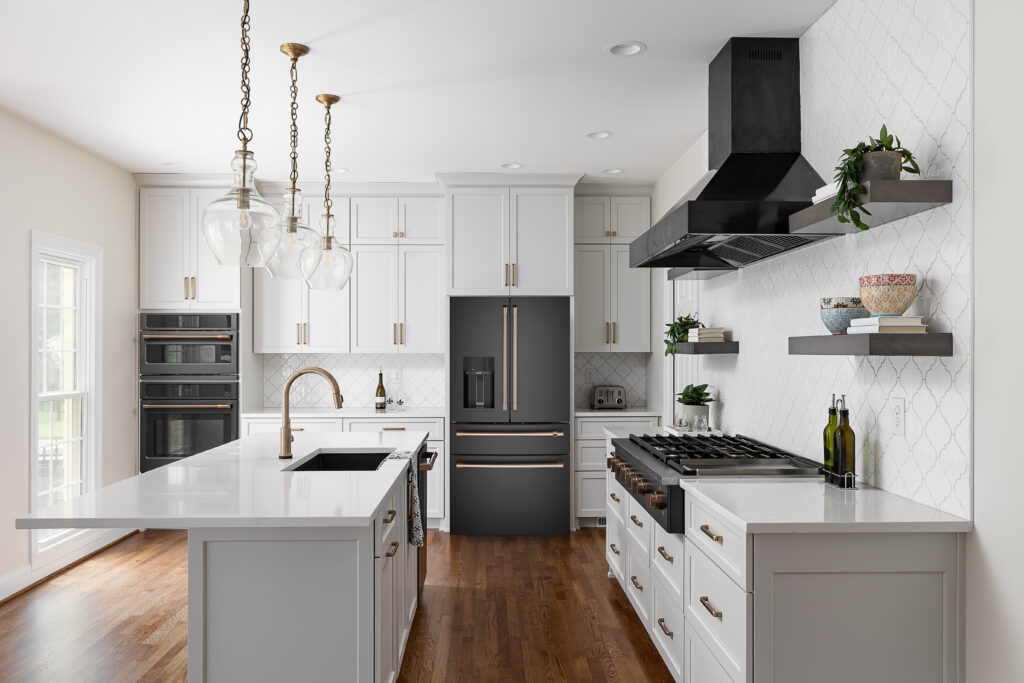For a long time, the kitchen was a space used as a utilitarian requirement. The dreaded daily question to lots of parents each day is “what’s for dinner?” In the mid-1900’s came the emergence of “convenience foods”– think canned, boxed, and frozen foods and ingredients, followed by the women’s movement which led to a change in the way the kitchen was used. It became the place of doing homework after school, and a place to gather during the big game. The kitchen is where difficult family conversations might occur, and big news is often shared. The kitchen’s functional use has shifted but its main purpose is, of course, still to store and make food. In recent years, kitchen design has evolved to make room for all of its needs, with the spotlight being on the cooking area – and this part of the kitchen simply won’t be upstaged.

Nowadays, cooking and baking are seen as legitimate hobbies, performed with care and leisure by men and women alike. Dinner is not necessarily a chore for all families, it’s a way to bond and do something together. Farm-to-table philosophy has come to the home kitchen and people are paying attention to what’s in their food, and how it’s prepared. This is especially true since the pandemic, when families were stuck at home and had the time to master the preparation of sourdough bread, for example.
Maybe you’re a “Great British Baking Show” enthusiast or an Anthony Bourdain fan (RIP). Or maybe you can recall spending quality time with your grandmother in the kitchen and want to replicate it with your littles. Whatever your reason for adopting serious cooking and baking skills, you’re going to want to have a kitchen that is suited for your needs.
You want a “chef’s kitchen.” So what goes into designing one of those?

A chef’s kitchen is designed to meet the needs of any professional chef. It has room to move, any emphasis on convenience, and upscale appliances, among other things.
Chef’s kitchens typically have enough space for more than one person to be working in the kitchen at a time. You’d be hard pressed to create one in the space assigned to a galley-style kitchen. Cooking and prepping food can be a family activity that brings families together, and you’re going to want the space to be able to do that without bumping into each other.
The L-shaped kitchen is one of the most popular kitchen layouts, with cabinets and countertops on two walls of the room. The U-shaped kitchen is also popular and similar to the L-shaped kitchen, just adding another wall of cabinets and countertops or a large island. These typically afford enough space for everyone without anyone treading on anyone’s toes.
The stove is one of the centerpieces of a chef’s kitchen. In order to accommodate the creation of a luxury meal, you should be looking for one with six to eight burners and a high gas BTU level. Many of these stoves will also have a range or griddle built in. A powerful ventilation system or hood is also necessary. Recent studies have shown that improperly vented gas stoves can cause respiratory problems.
Your grandma likely had a double oven, and so should you. When she wasn’t using both ovens for meal-prep, my grandmother used her second oven to keep the plates warm at a very low temperature. You don’t want to be serving your gourmet, labor-intensive meals on ice cold plates, after all. Plus double ovens are especially useful if you are entertaining or cooking a holiday meal with many courses.
Install more outlets than you think you may need. Your blenders, mixers, beaters, electric knives, coffee stations, tea kettle, etc. all need juice to perform. You’re not going to want to have to unplug one accessory to get another to work. This is a workspace, design it as such. Outlets every few feet above the countertops are essential to a chef’s kitchen.
Sinks– plural! You’re going to need at least two sinks to have the space to properly prep foods and keep dishes clean. Increasingly popular are deep pot-filler faucets, either located on the stove, so you don’t have to carry water-filled heavy pots from the sink to the stove, or on a kitchen island with its own sink. These often goose-necked or otherwise adjustable faucets are designed to easily fill even the deepest lobster pot in your kitchen.

A chef’s crown jewels are their knives. Even the most professional chefs take their own personal set of knives to their workspace. Critical to any chef’s kitchen is a place to store their stash of quality knives. This may be an exclusive drawer or it may be a magnetic rack. But keeping chef’s knives safely stored and within easy reach is a priority for a chef’s kitchen.
Just like you need more than one sink or stove, more than one dishwasher can elevate a regular kitchen to a chef’s kitchen. These are especially important if your plan is to entertain often. Who wants to be stuck in the kitchen waiting for one load of dishwashing to finish so you can load it up again?
Professional sub-zero fridges and freezers are another attribute of a chef’s kitchen. These appliances keep foods and ingredients longer and fresher than your standard big-box store refrigerator. They tend to be larger than home store appliances and have more drawers and pockets for storage to keep foods separate and odor-free.
If you’re going to invest in quality foods and ingredients to prepare your meals, if cooking and baking are indeed your favorite hobby, if you’re an entertainer who loves to host guests, investing in a chef’s-style kitchen is well worth the money. It will elevate your cooking experience, bring your family closer together, and create ease and joy in your kitchen. Bon appetit!
